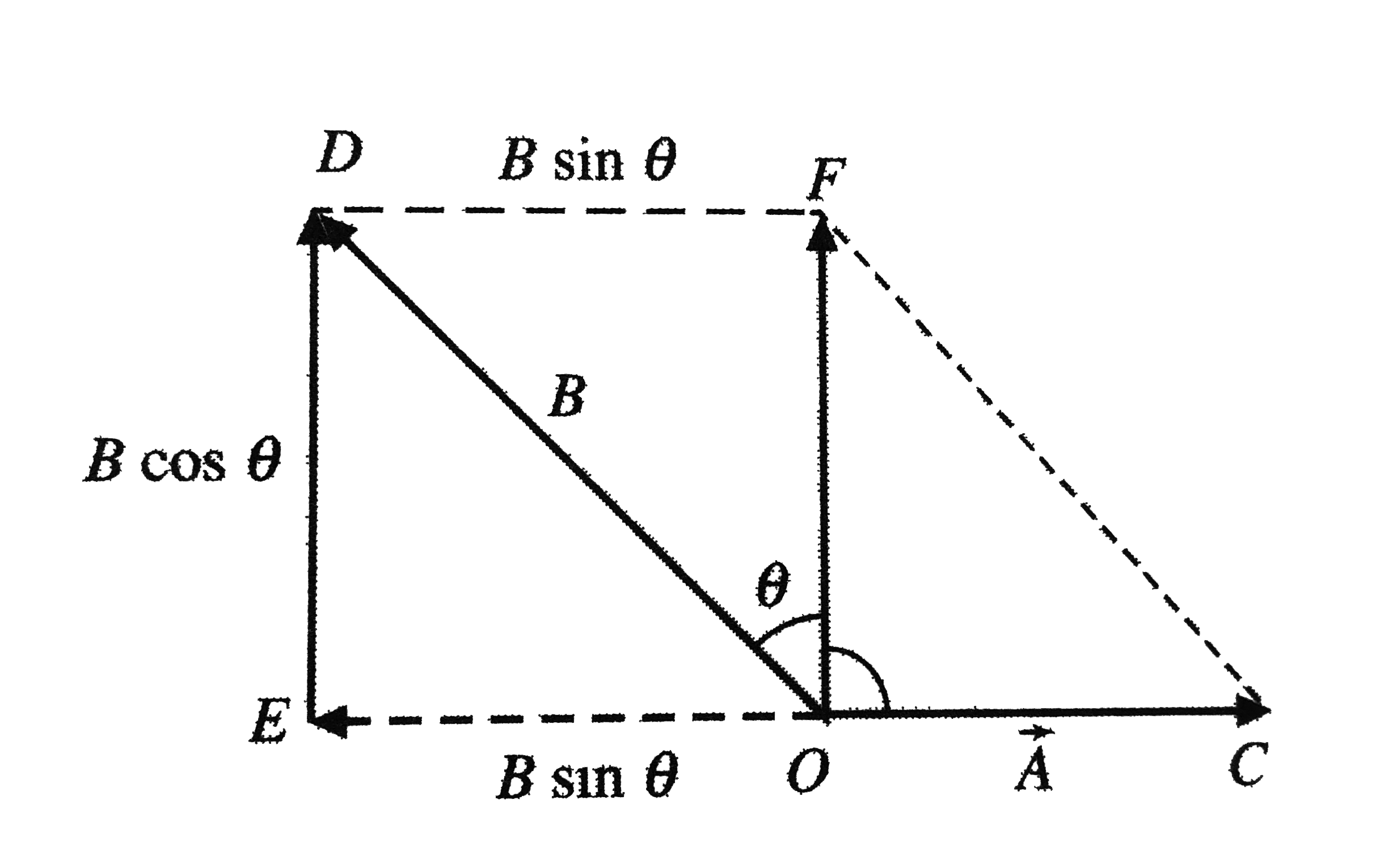The resultant of two vectors →A and →b is perpendicular to the vector →A and its magnitude is equal to half the magnitude of vector →B. The angle between →A and →B is
To solve the problem, we need to find the angle between the two vectors →A and →B given the conditions about their resultant vector. Let's break it down step by step.
Step 1: Understanding the Problem
We know that the resultant of two vectors →A and →B is perpendicular to →A. This means that the angle between the resultant vector →R and vector →A is 90∘.
Step 2: Magnitude of the Resultant Vector
According to the problem, the magnitude of the resultant vector →R is equal to half the magnitude of vector →B. Mathematically, we can express this as:
|→R|=12|→B|
Step 3: Using the Resultant Formula
The magnitude of the resultant vector →R when two vectors →A and →B are added can be calculated using the formula:
|→R|=√|→A|2+|→B|2+2|→A||→B|cosθ
where θ is the angle between →A and →B.
Step 4: Setting Up the Equation
Since |→R|=12|→B|, we can substitute this into the resultant formula:
(12|→B|)2=|→A|2+|→B|2+2|→A||→B|cosθ
This simplifies to:
14|→B|2=|→A|2+|→B|2+2|→A||→B|cosθ
Step 5: Rearranging the Equation
Rearranging gives us:
|→A|2+2|→A||→B|cosθ+|→B|2−14|→B|2=0
This can be further simplified to:
|→A|2+2|→A||→B|cosθ+34|→B|2=0
Step 6: Solving for cosθ
Let's denote |→A|=a and |→B|=b. The equation becomes:
a2+2abcosθ+34b2=0
This is a quadratic equation in terms of cosθ.
Step 7: Finding the Angle
Using the quadratic formula, we can find cosθ:
cosθ=−2ab±√(2ab)2−4⋅1⋅(a2+34b2)2⋅1
After simplification, we find that cosθ=−√32.
Step 8: Determining the Angle
The angle θ corresponding to cosθ=−√32 is:
θ=150∘(in the second quadrant)
Final Answer
The angle between vectors →A and →B is 150∘.
---
We know that the resultant of two vectors →A and →B is perpendicular to →A. This means that the angle between the resultant vector →R and vector →A is 90∘.
According to the problem, the magnitude of the resultant vector →R is equal to half the magnitude of vector →B. Mathematically, we can express this as:
|→R|=12|→B|
The magnitude of the resultant vector →R when two vectors →A and →B are added can be calculated using the formula:
|→R|=√|→A|2+|→B|2+2|→A||→B|cosθ
where θ is the angle between →A and →B.
Since |→R|=12|→B|, we can substitute this into the resultant formula:
(12|→B|)2=|→A|2+|→B|2+2|→A||→B|cosθ
This simplifies to:
14|→B|2=|→A|2+|→B|2+2|→A||→B|cosθ
Rearranging gives us:
|→A|2+2|→A||→B|cosθ+|→B|2−14|→B|2=0
This can be further simplified to:
|→A|2+2|→A||→B|cosθ+34|→B|2=0
Let's denote |→A|=a and |→B|=b. The equation becomes:
a2+2abcosθ+34b2=0
This is a quadratic equation in terms of cosθ.
Using the quadratic formula, we can find cosθ:
cosθ=−2ab±√(2ab)2−4⋅1⋅(a2+34b2)2⋅1
After simplification, we find that cosθ=−√32.
The angle θ corresponding to cosθ=−√32 is:
θ=150∘(in the second quadrant)
The angle between vectors →A and →B is 150∘.
Topper's Solved these Questions
- CHAPTERWISE NUMERIC /INTEGER ANSWER QUESTIONSBOOK - DISHA PUBLICATIONCHAPTER - CHAPTERWISE NUMERIC /INTEGER ANSWER QUESTIONSEXERCISE - CHAPTER -4 (LAWS OF MOTION)
15 Videos
- CHAPTERWISE NUMERIC /INTEGER ANSWER QUESTIONSBOOK - DISHA PUBLICATIONCHAPTER - CHAPTERWISE NUMERIC /INTEGER ANSWER QUESTIONSEXERCISE - CHAPTER -5 (WORK, ENERGY AND POWER)
15 Videos
- CHAPTERWISE NUMERIC /INTEGER ANSWER QUESTIONSBOOK - DISHA PUBLICATIONCHAPTER - CHAPTERWISE NUMERIC /INTEGER ANSWER QUESTIONSEXERCISE - CHAPTER -2 (Motion in a Straight Line)
15 Videos
- ATOMSBOOK - DISHA PUBLICATIONCHAPTER - ATOMSEXERCISE - EXERCISE-2: CONCEPT APPLICATOR
30 Videos
- COMMUNICATION SYSTEM BOOK - DISHA PUBLICATIONCHAPTER - COMMUNICATION SYSTEM EXERCISE - EXERCISE-2 : Concept Applicator
30 Videos
Similar Questions
Knowledge Check
The resultant of two vectors →A and →B is perpendicular to the vector →A and its magnitude is equal to half of the magnitude of the vector →B. Find out the angles between →A and →B.
 .A120B90C60D150
.A120B90C60D150The resultant of the vectors A and B is perpendicular to the vector A and its magnitude is equal to half the magnitude of vector B. The angle between →A and →B is :-
A120∘B150∘C135∘DNone of theseTwo vectors →A and →B have equal magnitudes. If magnitude of →A+→B is equal to n times the magnitude of →A−→B, then the angle between →A and →B is :-
Acos−1(n−1n+1)Bcos−1(n2−1n2+1)Csin−1(n−1n+1)Dsin−1(n2−1n3+1)
If two vectors →Aand →Bmake angle 30∘and45∘ with their resultant and →B has magnitude equal to 10, then find magnitude of →A.
View SolutionIf for two vector →A and →B, sum (→A+→B) is perpendicular to the difference (→A−→B). The ratio of their magnitude is
View SolutionIf for two vector →A and →B, sum (→A+→B) is perpendicular to the difference (→A−→B). The ratio of their magnitude is
View SolutionThe two vectors →A and →B are drawn from a common point and →C=→A+→B. Then, the angle between →A and →B is
View SolutionIf →a,→b are unit vectors such that the vector →a+3→b is peependicular to 7→a−→band→a−4→b is prependicular to 7→a−2→b then the angle between →aand→b is
View Solution

